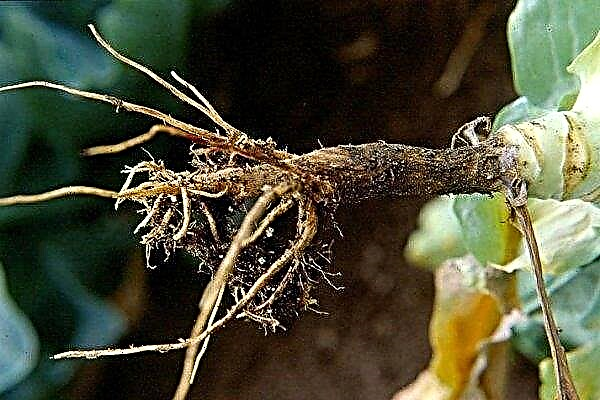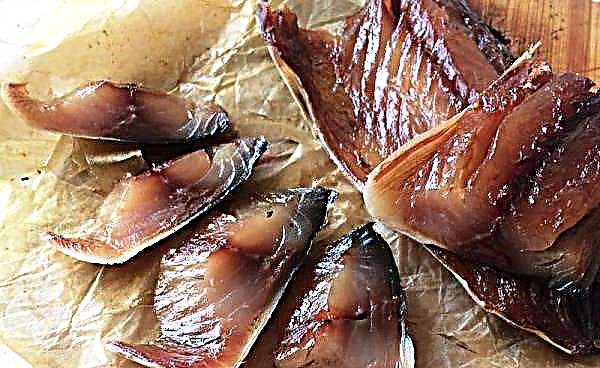Among indoor plants, ficuses are especially distinguished. These evergreen ornamental and deciduous plants are able to decorate any interior and bring a touch of comfort to your home environment. One of the representatives of these plants is the ficus Tineke. We will get acquainted with the conditions of its cultivation, as well as breeding methods.
Botanical description of the plant
Ficus Tineke is a variegated species of rubber-bearing ficus (elastic), an evergreen tree from the Mulberry family. In the native lands (India and southern Indonesia), the ficus reaches a considerable height - up to 40 m. Its growth under indoor conditions is limited by the capacity in which the plant grows, but even here it can grow up to 2 m. on short petioles (about 2.5 cm) and have an oval shape with a sharp end.
Did you know? Ficus elastic was cultivated to produce rubber used in industry. Hence its second name — rubbery.
Their length is an average of 25 cm and a width of 15 cm. They have a colorful color - green with white. The central part of the leaf plate is green, closer to the edges there is a lighter color, which at the edges becomes almost white. In the center is a pronounced leaf vein of light green and pink tones. Feathery venation. All parts of the plant contain milky juice. At home, the plant practically does not bloom. In the natural environment, it blooms with axillary flowers and forms oval fruits up to 1 cm.
What to look for when buying a plant
It is best to buy a young plant in the spring and summer, then its adaptation to new conditions will be easier. A young plant will not tolerate transportation to a new place at temperatures below + 16 ° C. In the specimen of your choice, the roots should not protrude from the pot or drainage hole. It is unacceptable to buy a plant with wet soil that exudes a bad smell - this indicates a rotten root system.
Important! At home, ficus must be put in a permanent place, but separately from other plants, and given 2 weeks for adaptation and quarantine.
The health of this indoor flower can be checked as follows: shake it or run your hand against the growth of leaves. If at least one sheet has fallen, then the purchase should be abandoned. Sometimes in the store the leaves of the plant are covered with polish for greater shine, therefore, when bringing the plant home, the leaves should be wiped with a damp cloth.
Conditions for growing at home
At home, optimal conditions should be arranged for the plant. Variegated varieties, to which the ficus Tineke belongs, need slightly more light and heat than specimens with completely green foliage.
Location and Lighting
This plant loves good lighting, but prefers diffused light. When grown on a southern window in the summer, it will need to be shaded from the hot rays of the sun or set aside from the window. Best of all, windows of eastern or western direction will suit him. With a lack of light, the variegation of the ficus Tineke becomes faded, the foliage turns yellow and falls. In winter, the flower must be provided with daylight hours of at least 7–8 hours.
Temperature and humidity
This tropical plant loves heat, therefore it is optimal to keep it at a temperature of +22 ... + 24 ° С. An adult plant can tolerate a drop in temperature to + 5 ° C, but for ficuses Tineke younger than 5 years old, a temperature below + 16 ° C should not be allowed.
In winter, a plant placed near a hot battery, as well as in a hot summer season, should be provided with sufficient air humidification by periodic spraying. Ficuses do not tolerate severe temperature extremes, as well as drafts. This should be taken into account when airing in the cold season. A stream of frosty air should not fall on the flower.
Soil and soil for the plant
The earth mixture for this plant must be nutritious and well permeable, with low or medium acidity. Such mixtures should be composed of peat, sod-leaf soil and sand in equal parts (for young plants). For adults, make a soil mixture of sand, turf and leaf soil in a ratio of 1: 2: 2.
Features of plant care
Caring for ficus Tineke is straightforward. This plant is unpretentious, but do not neglect the basic rules of care.
Watering Rules
Watering the ficus must be defended with warm water at room temperature. This should be done when the topsoil dries. The frequency of irrigation depends on external conditions (temperature, humidity). Usually, hydration is performed 2-3 times a week. In the cold period, watering is reduced to 1 time in 7 days. Watering with cold water is unacceptable.
Important! Ficus Tineke does not like waterlogging - this can cause the appearance of a number of fungal diseases.
The plant responds well to spraying with soft water from a spray bottle, especially in the hot summer season. Periodically, you should wipe the leaves of the ficus with a damp sponge and organize a warm shower once a month.
Top dressing
In order for the ficus Tineke to grow well, it must be fertilized. The plant is fed 1 time in 2 weeks during the period of active vegetation (March-September). To do this, use mineral fertilizers, which can be bought in a specialized store.
For feeding, you can also use the following fertilizers:
- A solution of nitrophoska in the ratio of 1 tsp. per 1 liter of water. Ficus is watered with this solution after wetting.
- Mullein infusion. It is also applied to the soil after watering.
In winter, top dressing is reduced or minimized.
Pruning
During the year, as necessary, do sanitary pruning, removing old, dried or diseased leaves. Periodically pruning old shoots is recommended to stimulate the appearance of new ones.
Important! Milky juice appears on the slices of the ficus Tineke, which can cause allergic rashes on the skin, so work on pruning the plant should be carried out with protective gloves.
Pruning is also carried out to form a crown, because the plant grows rapidly and can stretch to the ceiling. This procedure must be carried out in late February or early March.
Transfer
When the grown ficus Tineke roots become closely in the pot, it needs to be transplanted into a large container. This procedure is carried out in the spring (March-May). Young specimens are transplanted once a year, and adults (over 5 years old) - once every 3 years. A new pot is taken 2-3 cm larger than the previous one or slightly larger than the root system.
It can be from any material, but it must have a drainage hole. Expanded clay or broken bricks are used as drainage. Adult large ficuses do not transplant, but replace the topsoil with 3 cm 1 time in 2 years.
The transplant is done using the transshipment method as follows:
- Ficus is watered before being removed from the old tank.
- A drainage layer is lined at the bottom of the new tank, and a little soil is poured on top.
- Then the plant is carefully removed along with an earthen lump so as not to damage the roots.
- The plant is placed in a new container and covered with soil, holding the flower in an upright position. They compact the soil a little and make sure that there are no voids.
 If rotten roots were found during transplantation, the transshipment method will not work. Ground from the roots must be carefully cleaned and washed with roots, and then cut off all the rotten parts. Slices are dried, treated with fungicide and only after that the plant is planted in a new pot.
If rotten roots were found during transplantation, the transshipment method will not work. Ground from the roots must be carefully cleaned and washed with roots, and then cut off all the rotten parts. Slices are dried, treated with fungicide and only after that the plant is planted in a new pot.Crown formation
Ficus Tineke grows quickly, so its growth must be limited and shaped. If you need to form a flower in the form of a bush, then you should pinch all the shoots at a height of 10-15 cm. After this procedure, the lateral branches begin to grow. When they reach the same length as everyone else, they should also be pinched. Shoots that are directed inside the bush do not cut at first, but when the ficus grows and begins to thicken, they remove the extra internal shoots to ensure normal illumination of such a bush.
Did you know? In India, in the city of Cherapundji, the local attraction is the live suspension bridges grown from ficus elastic. To do this, the aerial roots of the plant are directed through a stream or river to the other side.
If the main shoot is well developed in ficus, then it is formed in the form of a tree. For this purpose, cut all the shoots, leaving only 3-5 of the top. When the ficus grows to the required height, pinching the apex is done, and the lateral processes are removed. All sections of the slices are gently wiped with a cloth and sprinkled with crushed activated carbon to avoid the entry of harmful bacteria and infections. To shoots sprouted from all sides evenly, the pot with the plant should be periodically rotated to the window in different directions in a circle.
Methods of reproduction at home
The process of reproduction occurs in the spring. To do this, use the method of cuttings or air layering. A well sharpened knife cut obliquely cuttings 12-15 cm long from the tops of the shoots of ficus. The juice is washed off the cut and the stalk is placed in a container with water for a couple of hours. The leaves that are on the cuttings (usually 2-3 pieces) are cut to half and twisted into a tube to reduce evaporation, and the bottom sheet is removed. Then the cuttings are removed from the water and allowed to dry for 2-3 hours.
To root cut cuttings, 2 methods are used:
- Rooting in water. Cuttings are kept in water for 2–4 weeks until the roots appear. The container with them is placed in a well-lit place with a temperature of + 23 ... + 25 ° C and a humidity of 80%. Leaves should not come in contact with water, otherwise they will rot. In water, in order to avoid the occurrence of rotting processes, you can dissolve a tablet of crushed activated carbon. Cuttings with emerging roots are planted in light soil.
- Landing in the substrate. After drying the shank, its slice is sprinkled with crushed activated carbon. Prepare the soil from the substrate, peat, sand and vermiculite in equal proportions, in which the cuttings are planted. Planting is covered with a bag of polyethylene, creating a greenhouse effect. Every day, remove the bag for ventilation for 15 minutes and carry out the moistening of such a planting. The formation of new leaves on the cuttings will talk about the formation of the root system.
 Reproduction of ficus can also be carried out using layering. To do this, make incisions on the trunk of the ficus and insert toothpicks or matches into them. Sphagnum moss is attached to these places, and wrapped with a polyethylene film on top, creating a greenhouse effect. When the roots appear (usually this occurs after 3-5 months), the sprouts are cut and planted in separate pots.
Reproduction of ficus can also be carried out using layering. To do this, make incisions on the trunk of the ficus and insert toothpicks or matches into them. Sphagnum moss is attached to these places, and wrapped with a polyethylene film on top, creating a greenhouse effect. When the roots appear (usually this occurs after 3-5 months), the sprouts are cut and planted in separate pots.Possible growing difficulties
The appearance of diseases and pests is often associated with violations of the care of ficus.
Did you know? Feng Shui experts say that the ficus, located on the southeastern side of the dwelling, will give its inhabitants the ability to think wisely, relieve aggression. The copy located in the kitchen will attract money to the house, and the one growing in the bedroom — relieve insomnia.
Consider the main difficulties that can be encountered when growing this plant:
- If the foliage fades, then you need to moisturize, since this phenomenon occurs due to lack of moisture.
- Yellowing and falling of the leaves often occurs during overflows and excessive soil moisture. Watering should be reduced and the soil should be dried in a pot.
- If the color of the leaves is discolored, and the growth of the plant slows down, then it is necessary to fertilize or transplant the plant with an examination of the root system.
- Dark brown spots appeared on the leaves, they fall off - this means a low air temperature in the room. The flower needs to be moved to a warmer room or to increase the temperature in the place of growth.
- The appearance of powdery white formations on the underside of the leaf indicates the presence of a powdery mealybug. Leaves should be washed with a sponge dipped in soapy water and the Aktara insecticidal preparation should be used.
- The appearance of a thin web and interspersed with a reddish color on the leaves indicates the appearance of a red spider mite. They are processed by means of Aktara or Sunmayt. They also increase the humidity in the room, since dry air provokes the development of these pests.
- With the appearance of brownish growths on the leaves, you can guess that the plant is affected by such a pest as scale insects. The leaves are cleaned with cotton dipped in alcohol, or they are treated with Actellic insecticide.
If you follow all the rules for the care of ficus Tineke and provide him with all the necessary conditions, then this flower will delight you with its exotic look for a long time.












